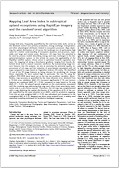| Journal Article |
 |
|
| Article Title | Mapping Leaf Area Index in subtropical upland ecosystems using RapidEye imagery and the randomForest algorithm | | Author | Philip Beckschäfer, Lutz Fehrmann, Rhett Daniel Harrison, Xu Jianchu and Christoph Kleinn | | Year | 2013 | | Journal Title | iForest – Biogeosciences and Forestry | | Institution | iForest – Biogeosciences and Forestry | | Volume | 7 | | Pages | 1-11 | | Call Number | JA0543-14 | | Keywords | Ecosystem Monitoring, Forest and Vegetation Parameters, Leaf Area
Index (LAI), Hemispherical Photography, Map Uncertainty, Vegetation Indexes,
Image Texture, Xishuangbanna |
|
| Abstract: |
| Canopy leaf area, frequently quantified by the Leaf Area Index (LAI), serves as
the dominant control over primary production, energy exchange, transpiration,
and other physiological attributes related to ecosystem processes. Maps depicting
the spatial distribution of LAI across the landscape are of particularly high
value for a better understanding of ecosystem dynamics and processes, especially
over large and remote areas. Moreover, LAI maps have the potential to
be used by process models describing energy and mass exchanges in the biosphere/
atmosphere system. In this article we assess the applicability of the
RapidEye satellite system, whose sensor is optimized towards vegetation analyses,
for mapping LAI along a disturbance gradient, ranging from heavily disturbed
shrub land to mature mountain rainforest. By incorporating image texture
features into the analysis, we aim at assessing the potential quality improvement
of LAI maps and the reduction of uncertainties associated with LAI
maps compared to maps based on Vegetation Indexes (VI) solely. We identified
22 out of the 59 image features as being relevant for predicting LAI. Among
these, especially VIs were ranked high. In particular, the two VIs using RapidEye’s
RED-EDGE band stand out as the top two predictor variables. Nevertheless,
map accuracy as quantified by the mean absolute error obtained from
a 10-fold cross validation (MAE_CV) increased significantly if VIs and texture
features are combined (MAE_CV = 0.56), compared to maps based on VIs only
(MAE_CV = 0.62). We placed special emphasis on the uncertainties associated
with the resulting map addressing that map users often treat uncertainty statements
only in a pro-forma manner. Therefore, the LAI map was complemented
with a map depicting the spatial distribution of the goodness-of-fit of the model,
quantified by the mean absolute error (MAE), used for predictive mapping.
From this an area weighted MAE (= 0.35) was calculated and compared to the
unweighted MAE of 0.29. Mapping was done using randomForest, a widely used
statistical modeling technique for predictive biological mapping. |
|